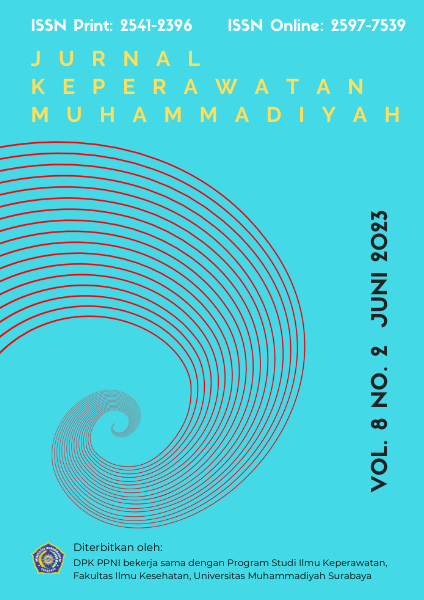Hubungan Praktik Kebersihan Diri Terhadap Kejadian Stunting Pada Anak Balita
DOI:
https://doi.org/10.30651/jkm.v8i2.18399Keywords:
Self-Cleaning, Stunting, In Children Under FiveAbstract
Objective: Stunting resulting from chronic malnutrition and infections over 1000 especially during the first days of life (HPK). The fetus to the 23 months old. Children are stunting when the length or height has been under minus two standard deviations seumurnya the length or height (Hasrul et al., 2020).   Future generations the nation today have to under fives so needs special attention  (H. Hasrul & Nurdin, 2020).  The purpose of this research look at the relationship the foster parents in terms of hygiene practices to his son to events stunting
Methods: Â Research methodology use observational with the design research case control. Â It is a whole population in research families that have toddlers to in the work area of Puskesmas Lawawoi. The sample tehnik systemic in random sampling Obtained a total of 102 Children under five The children as many as 51 stunting (Case) and As many as children who are not stunting 51 (Control)
Results:  This research has been carried out in Kelurahan Batu Lappa  working area UPT Puskesmas Lawawai  as much 102 sampel.  Results of the study show there is a link between self-hygiene practices with stunting events shown by the p-value  = 0,016 and OR = 3,42  Which means cleaning practices downside risk having himself  3,42 times  Higher to be stunting than good self-cleaning practices
Conclusion: a  connection self-hygiene against  Stunting incident in children under fiveReferences
Aisah, S., Ngaisyah, R. D., & Rahmuniyati, M. E. (2019). Personal Hygiene Dan Sanitasi Lingkungan Berhubungan dengan Kejadian Stunting di Desa Wukirsari Kecamatan Cangkringan. Prosiding Seminar Nasional Multidisiplin Ilmu, 1(2), 49–55. http://prosiding.respati.ac.id/index.php/PSN/article/download/182/176
Annissa, Suriani, S., & Yulia. (2018). Kejadian Stunting Pada Balita Di Wilayah Kerja Puskesmas Kilasah Serang Banten. Jurnal Dunia Kesmas, 8(1), 45–52.
Berhe, K., Seid, O., Gebremariam, Y., Berhe, A., & Etsay, N. (2019). Risk factors of stunting (chronic undernutrition) of children aged 6 to 24 months in Mekelle City, Tigray Region, North Ethiopia: An unmatched case-control study. PLoS ONE, 14(6), 1–11. https://doi.org/10.1371/journal.pone.0217736
Hasrul, A. dan. (2019). Gizi dalam Kesehatan (R. O. Akbar (ed.); Edisi Kedu). PENERBIT CV CONFIDENT.
Hasrul dkk. (2022). STUNTING: FENOMENA ?? In H. Hasrul (Ed.), Buku Monograf STUNTING : FENOMENA ?? (pertama, hal. 1–80). Perkumpulan Rumah Cemerlang Indonesia.
Hasrul, H., & Nurdin, S. (2020). Pengaruh pengetahuan keluarga terhadap status gizi balita. Jurnal Kebidanan dan Keperawatan Aisyiyah, 15(2), 147–156. https://doi.org/10.31101/jkk.797
Hasrul, Sirajuddin, W., Melinda, P., Wulansari, Mulhaeri, Rahmayanti, D., Asniar, & Hafid, A. (2020). Implementasi Pola Asuh Autoritatif Dalam Menurunkan Kejadian Stunting. Jurnal Keperawatan Muhammadiyah, 8(1), 51.
Islah Wahyuni. (2020). Analisis Faktor Masalah Pertumbuhan (Status Gizi, Stunting) Pada Anak Usia < 5 Tahun Di Wilayah Kerja Puskesmas Sidomulyo Kota Pekanbaru. Jurnal Kebidanan Mutiara Mahakam, 8(1), 51–70.
Mami, L. (2020). DAMPAK KUALITAS SANITASI LINGKUNGAN TERHDAP STUNTING. JURNAL STAMINA, 3(12), 865–872. https://doi.org/10.1017/CBO9781107415324.004
Nshimyiryo, A., Hedt-Gauthier, B., Mutaganzwa, C., Kirk, C. M., Beck, K., Ndayisaba, A., Mubiligi, J., Kateera, F., & El-Khatib, Z. (2019). Risk factors for stunting among children under five years: A cross-sectional population-based study in Rwanda using the 2015 Demographic and Health Survey. BMC Public Health, 19(1), 1–10. https://doi.org/10.1186/s12889-019-6504-z
Permatasari, D. F., & Sumarmi, S. (2018). Differences of Born Body Length, History of Infectious Diseases, and Development between Stunting and Non-Stunting Toddlers. Jurnal Berkala Epidemiologi, 6(2), 182. https://doi.org/10.20473/jbe.v6i22018.182-191
Sukamawati, Urwati Wusqa Abidin, Hasmia Abidin, W. (2021). HUBUNGAN HYGIENE DAN SANITASI LINGKUNGAN TERHADAP KEJADIAN STUNTING PADA BALITA. Peqguruang: Conference Series, 3(2), 1–9.
Sutarto, S., Indriyani, R., Puspita Sari, R. D., Surya, J., & Oktarlina, R. Z. (2021). Hubungan Kebersihan diri, Sanitasi, dan Riwayat Penyakit Infeksi Enterik (diare) dengan Kejadian Stunting pada balita usia 24-60 bulan. Jurnal Dunia Kesmas, 10(1), 56–65. https://doi.org/10.33024/jdk.v10i1.3415
Yudianti, Y., & Saeni, R. H. (2017). Pola Asuh Dengan Kejadian Stunting Pada Balita Di Kabupaten Polewali Mandar. Jurnal Kesehatan Manarang, 2(1), 21. https://doi.org/10.33490/jkm.v2i1.9
Downloads
Published
Issue
Section
License
- Penulis tetap memegang hak atas karyanya dan memberikan hak publikasi pertama kepada jurnal ini yang secara simultan karya tersebut dilisensikan di bawah:Â Creative Commons Attribution-ShareAlike 4.0 International (CC BY-SA 4.0)













